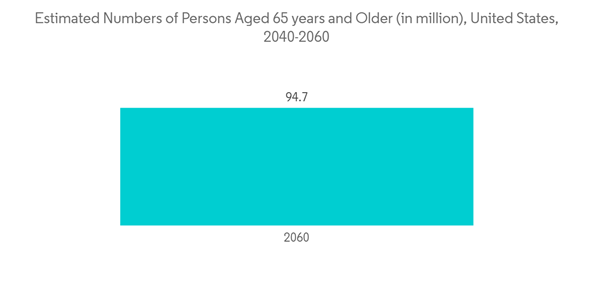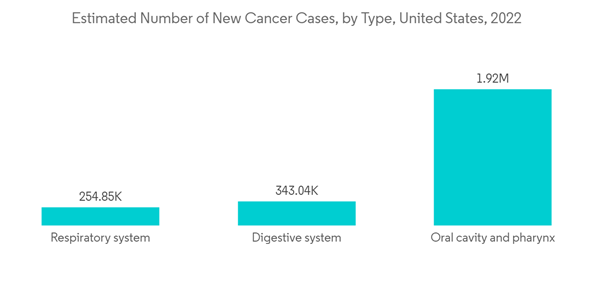COVID-19 had a profound impact on the anesthesia market owing to the cancellations of anesthesia procedures in the beginning due to the suspension of surgical procedures in the country. The use of inhalation anesthetics for sedation during longer-term breathing with anesthesia machines has increased in hospitals. COVID-19 has a wide range of effects on surgical procedures, including labor force and staffing difficulties, procedural prioritizing, and intraoperative viral transmission risk. Due to the high number of cases of COVID-19 in the early stages of the pandemic, all hospitals around the world canceled all scheduled and elective procedures. Acute surgical emergencies were still unavoidable, but they were dealt with in a timely and prudent manner. However, the market is recovering from the last two years since the restrictions have been lifted and are expected to show a stable growth rate during the forecast period.
In addition, the technological advancements in anesthesia, the increasing geriatric population and a growing number of surgeries, and a significant patient pool of patients with chronic diseases are actively affecting the growth of the studied market.
Owing to the high prevalence of diseases, this country has become the hub of the major players. According to the American Heart Association's Heart & Stroke Statistics 2022 Update, more than 356,000 out-of-hospital cardiac arrests (OHCA) are reported every year in the United States, with over 90% of these being fatal. The annual incidence of non-traumatic OHCA is estimated to be 356,461, or about 1,000 people each day. This will lead to increased adoption of anesthesia devices required during emergency surgery necessary after cardiac arrest, thereby contributing to the growth of the market.
The increasing occurrence of heart disease causes a burden on the healthcare system of the country. The rise in the occurrence of chronic cardiovascular diseases like heart failure and coronary artery disease, along with the increasing geriatric population, is one of the key factors which is expected to fuel the market growth. For instance, as per the report published in April 2021, about 16.5% of the United States population, or 54 million, are aged over the age of 65 in 2020. The number is expected to reach 74 million by 2030. The number of people over the age of 85, who are at risk of developing heart disease in the country, is expected to increase significantly. Such an increase in the elderly population leads to the rising demand for anesthesia devices, thereby contributing to the growth of the market.
Therefore, owing to the aforementioned factors, such as technological advancement and growing demand for anesthesia devices, the studied market is anticipated to witness growth over the analysis period. However, the high cost of equipment and difficulties associated with the usage of anesthesia devices is likely to impede the market growth.
United States Anesthesia Devices Market Trends
Anesthesia Work Station to Witness Steady Growth Over the Forecast Period
Anesthesia workstations are user-friendly and customizable. They are being offered features, including storage, writing surface, lighting, valves, and gauges at a reach, along with main functionalities. They consist of a ventilator, carrier gas, an agent delivery system, a scavenging system, and monitors. The ability of these devices to optimize anesthesia workflow and reduce process costs with integrated features is boosting anesthesia workstations' popularity among medical professionals.Currently, anesthesia workstations are designed to provide anesthesia gas delivery and monitoring capabilities, combined with advanced ventilation features, such as information management, writing desks, and drawers, to form an integrated anesthesia care station. In addition, the lesser human interaction and provision of assistance at many levels, by reducing the time and effort of a practitioner, are found to be the other factors associated with the increasing demand for workstations. The growth of this market in the United States is also attributed to the equipment's capability to integrate with various devices, as well as the display of anesthesia, ventilation, and hemodynamic data on a single screen, for streamlined decision-making.
Moreover, according to the CDC article released in July 2022, 12.1 million Americans are expected to have atrial fibrillation (AFib) by the year 2030. AFib raises a person's chance of having a stroke. AFib was linked to an approximately five-fold increased risk of ischemic stroke after typical stroke risk variables were taken into consideration. About 1 in 7 strokes are brought on by AFib. In the United States, AFib is the predominant diagnosis in more than 454,000 hospital admissions annually. Thus, the increasing prevalence of AFib is expected to increase segment growth as the patients require anesthesia.
Additionally, the increasing geriatric population who are prone to diseases and in need of surgeries is expected to drive the demand for anesthesia devices during the forecast period. Thus, the integration of various devices into one machine will reduce maintenance time and increase efficiency, thus, expanding the market.
Significant Patient Pool with Chronic Diseases is Expected to Propel the Market growth.
Several chronic diseases like cancer, COPD, diabetes, and other diseases require surgical procedures which use anesthesia devices to deliver inhalational anesthesia.According to the American Cancer Society Cancer Statistics 2022, 1,918,030 new cancer cases are predicted to occur in the United States in 2022. Out of the total cancer cases, breast cancer is estimated for 290,560 new cases, leukemia with 60,650 new cases, and lymphoma with 89,010 new cases in the United States in 2022. The treatment of cancers requires surgeries that utilize anesthesia devices, thereby propelling the anesthesia devices market in the country.
Also, as per the IDF 10th edition 2021 report, the United States of America ranked in the fourth position among the top 10 countries/ territories with the maximum number of diabetes in 2021. The report mentioned that 32.2 million people aged 20-79 years in the United States had diabetes in 2021 and the number is expected to reach 36.3 by 2045. As per the same report, the highest diabetes-related health expenditure is observed in the United States of America, with USD 379.5 billion in 2021. The high burden of chronic diseases is estimated to propel the demand for more innovative anesthesia devices for a smooth treatment procedure, driving the anesthesia devices market in the country during the forecast period.
United States Anesthesia Devices Industry Overview
The United States anesthesia devices market is moderately competitive and consists of several major players. With the rising patient awareness levels and high prevalence of diseases, and a rising number of surgeries, few other smaller players are expected to enter the market in the coming years. Some major players are B. Braun SE AG, Medtronic PLC, Draegerwerk AG, Koninklijke Philips NV, and Fisher & Paykel Healthcare, among others.Additional Benefits:
- The market estimate (ME) sheet in Excel format
- 3 months of analyst support
This product will be delivered within 2 business days.
Table of Contents
Companies Mentioned (Partial List)
A selection of companies mentioned in this report includes, but is not limited to:
- Ambu A/S
- B. Braun SE
- Draegerwerk AG
- Fisher & Paykel Healthcare
- GE Healthcare
- Koninklijke Philips NV
- Medtronic PLC
- Mindray Medical International Limited
- Smiths Medical
- Teleflex Inc.










